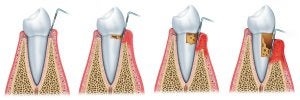 Gum disease is a condition so common that approximately one in two American adults suffers from it. Particularly concerning is that many people are unaware of this threat to their oral health. Periodontal disease may begin with tender gums, but without treatment, it can eventually lead to missing teeth. Once tooth loss occurs, dentures or dental implants in Schaumburg may be necessary to restore speaking and chewing capabilities. To protect yourself from the effects of gum disease, it is important to address symptoms as soon as they present so that this condition does not progress to a more advanced stage.
Gum disease is a condition so common that approximately one in two American adults suffers from it. Particularly concerning is that many people are unaware of this threat to their oral health. Periodontal disease may begin with tender gums, but without treatment, it can eventually lead to missing teeth. Once tooth loss occurs, dentures or dental implants in Schaumburg may be necessary to restore speaking and chewing capabilities. To protect yourself from the effects of gum disease, it is important to address symptoms as soon as they present so that this condition does not progress to a more advanced stage.
First Stage: Gingivitis
Periodontal disease develops due to plaque accumulation. Plaque forms when bacteria in the mouth combine with food particles to create a sticky byproduct. This byproduct then builds on tooth enamel. Diligent brushing and flossing can often remove plaque before it causes harm, but when left on teeth for too long, this substance can irritate nearby gums. This inflammation indicates the first stage of gum disease, gingivitis. Gingivitis typically does not produce pain. However, those with it may notice issues such as bleeding or red gums and should see a dentist for these warning signs.
Middle Stage: Periodontitis
When gum inflammation persists, gingivitis can evolve into periodontitis. In response to the presence of plaque, the gums may retract from the gumline. Because gum tissue helps to keep teeth stable, this side effect can initiate the loosening of the teeth. In addition, once gum recession begins, the damage done to gum fibers becomes permanent. Gum recession can also make it easier for bacteria and food debris to collect at the gumline, furthering the advancement of gum disease.
Final Stage: Advanced Periodontitis
Teeth, gum tissue, and underlying bone work together to create a strong and sturdy smile. As the gums continue to deteriorate, periodontal disease can progress to the jawbone. If gum tissue and bone cannot hold the teeth in place, they may eventually shift or fall out. Advanced periodontitis occurs with noticeable movement of the teeth. Since neither bone nor gum tissue can regenerate, affected teeth may require tooth extraction. For those who are diagnosed with advanced periodontitis, help is available. Depending on the need of the patient, a dentist can provide dentures or dental implant surgery to restore the health and appearance of the smile.
Reference: http://www.colgate.com

